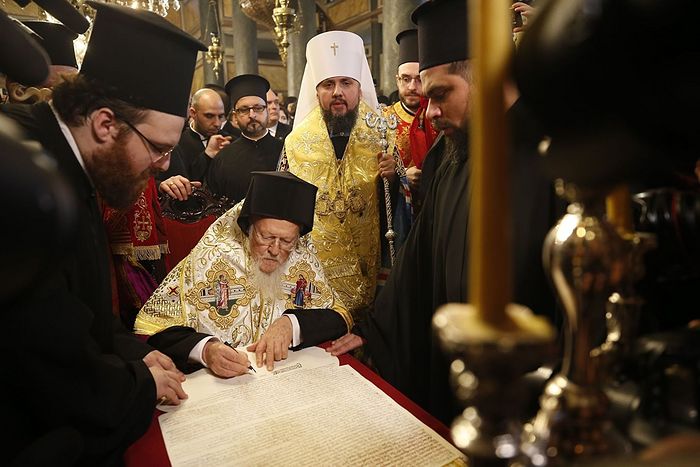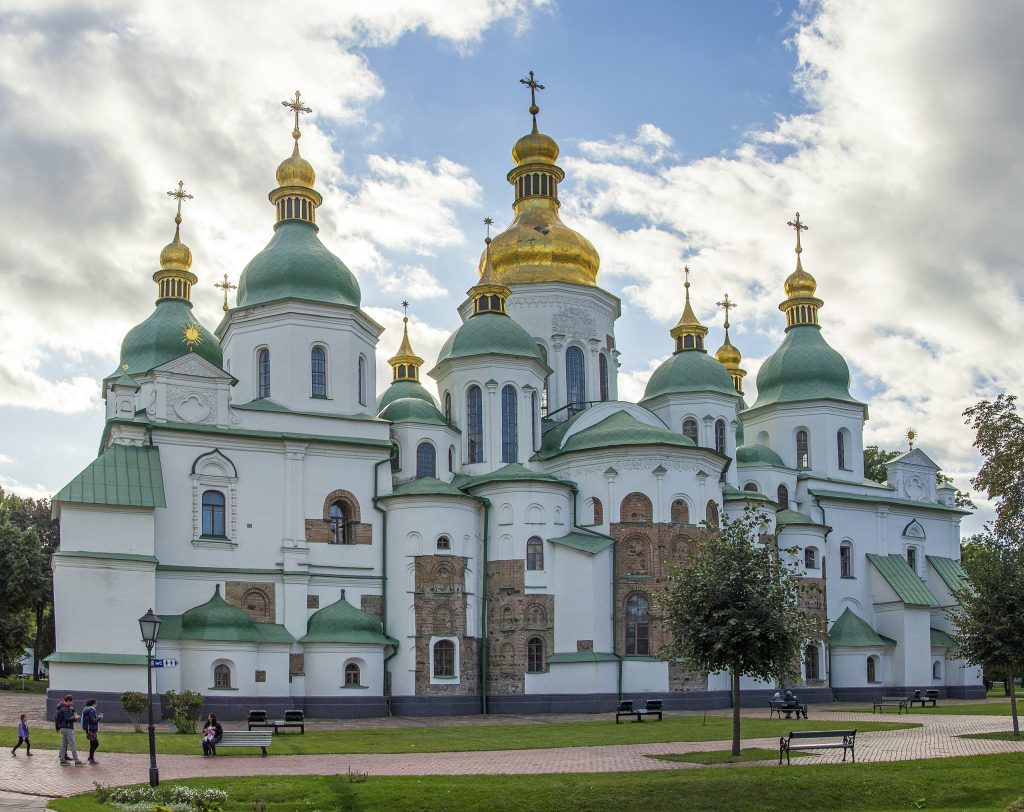On 15 December 2018 a unification council decided to gather in Kyiv to achieve the recognition of independence of the Ukrainian Orthodox Church (UOC). On 5 January 2019 the Ecumenical Patriarchate of Constantinople (POC), whose Ecumenical Patriarch – currently, Bartholomew I – enjoys the status of primus inter pares among the world’s Eastern Orthodox prelates and is considered the representative and spiritual leader of Eastern Orthodox Christians, decided to grant the tomos of autocephaly and thus to acknowledge the birth of the independent UOC with canonical jurisdiction over Ukraine. To be sure, the idea of an autocephaly for the Orthodox Church in Ukraine is not new, as it appeared soon after the dissolution of the Soviet Union and the birth of an independent Ukraine, being promptly opposed by the then Muscovite Patriarch Alexy II. Still, Russia has overseen the Ukrainian church for 332 years by authority of a synodal letter issued in 1686. Since its birth, this new ecclesiastical entity found itself coexisting next to the Ukrainian Orthodox Church linked to the Moscow Patriarchate – or Russian Orthodox Church (ROC) – and the Ukrainian Greek Catholic Church (UGCC) – or Uniate Church. On behalf of the ROC, Metropolitan Hilarion of Volokolamsk, the Moscow patriarchate’s head of external church relations, announced that Russia hoped that the Patriarchate of Constantinople would change its mind, otherwise until these “unlawful decisions made by Constantinople” were in force, the ROC would not be able to communicate with the Constantinopolitan Church, which was “in the midst of a schism”. At the same time, the former Ukrainian president, Petro Poroshenko stated that autocephaly represented part of Kyiv’s pro-European strategy, calling Moscow’s loss of control over the UOC as “the fall of the Third Rome”, that is, the conceptual claim of Moscow’s global domination. This rivalry between Constantinople and Moscow is not new and has been a feature of Eastern Orthodoxy since the times of the Council of Ferrara-Florence (1431-1449), when the Byzantine church accepted for a short time to overcome the Great Schism of 1054 while the Muscovite church opposed any idea of reconciliation with Rome. During his patriarchate, Kirill has often accused Bartholomew of engaging in a too close relationship with the Roman Catholic Church of Pope Francis. From a broader perspective, the recognition of the UOC’s autocephaly resulted on one hand in the ROC’s decision to severe the relations with the POC and, on the other, in a heated dispute among Eastern Orthodox Churches, from the Balkans to the Caucasus.

Apart from the theological and religious aspects, the Phanar’s decision has concealed geopolitical consequences. In Ukraine, the breaking of the ROC’s eucharistic unity with the POC was seen as “the beginning of an international religious conflict between Orthodox churches”, as the outbreak of a new schism, and as “an annexation of the territories of the Ukrainian Orthodox Church, comparable to the annexation of Crimea”. Moreover, the decision seems to have directly influenced the desire of the primate of the ROC Kirill, Patriarch of Moscow and all Rus’, to outspokenly support Putin’s 2022 military intervention in Ukraine in order to preserve the institution of the ROC throughout the post-Soviet space. As a matter of fact, with the 2019 recognition of the Ukrainian autocephaly, the Patriarch of Moscow and all Rus’ had “lost” one of the “Russias”. In practical terms, the creation of an autocephalous Ukrainian church translated into the ROC’s loss of jurisdiction over a significant number of Ukrainian eparchies and parishes and thus over the revenues that they produce – before the Ukrainian schism, over a third of all the parishes subordinate to Moscow were in Ukraine – and in the end to its status as largest Orthodox Church in the world. Also, the Russian government is aware that an independent Ukrainian Church means that Moscow will have less opportunities to exercise its soft power influence over Ukraine, which has been mainly pivoting around the concept of the Russkiy Mir – which is strictly connected to the religious narrative and worldview of the ROC.
The ROC seeks to blackmail the POC by accusing it of breaking up the Orthodox world and encouraging schisms. To hold the POC responsible for the split, the ROC finds support from other Eastern Orthodox churches. As anticipated, the reactions of the other Orthodox churches to the recognition of the autocephaly of the UOC have been divergent. Among the Orthodox patriarchates and autocephalous churches, the only that currently recognize the UOC are the Ecumenical Patriarchate of Constantinople, the Orthodox Church of Greece, the Orthodox Church of Alexandria, and the Orthodox Church of Cyprus. However, other churches have not yet recognized the UOC, manifesting more nuanced stances. First, the Bulgarian Orthodox Church has not taken an official position on the independence of the UOC. By tradition, the Bulgarian Orthodox Church has been leaning towards Russian Orthodoxy. Nonetheless, some frictions within the Bulgarian Orthodox Church have occurred between the sturdily pro-Russian and the more moderate factions, although much of the hierarchy does not wish to upkeep a firm position in the dispute between Moscow and the Phanar. Second, also the Romanian Orthodox Church has not adopted an official position on the autocephaly of the UOC, still there has been an open rivalry between the Romanian Orthodox Church and the ROC for the influence in the Republic of Moldova, where the Moldovan Orthodox Church, which is obedient to Moscow, has played a dominant role. Third, in the case of Serbia, the Serbian Orthodox Church (SOC) fully supports Moscow’s position, not only because of its proverbial close cooperation with Moscow, but also due to its fears of the rise of other independent churches in the former Yugoslav countries of Montenegro, North Macedonia – whose church obtained autocephaly in 2022 –, and Bosnia-Herzegovina.

Fourth, because of Belgrade’s standpoint, the Orthodox churches in North Macedonia and Montenegro considered the grant of the tomos of autocephaly to the UOC as the chance of achieving their autonomous status in the Orthodox world. For instance, as anticipated, the Macedonian Orthodox Church, which separated from the Serbian Patriarchate in 1967 but has been considered schismatic by the Serbian synod, was formally reintegrated into the mainstream Eastern Orthodox community in 2022, when the Ecumenical Patriarchate accepted it into communion, recognizing North Macedonia as its canonical territory. Contrariwise, despite its hopes raised by the birth of the UOC, the Montenegrin Orthodox Church, which was established in 1993, has never been canonically recognized neither by the Phanar nor by any other Orthodox Church, and up to date the official religious institution in Montenegro stays the SOC. Finally, the Georgian Orthodox Church does not recognize the autocephaly of the UOC. In Georgia the issue has been made more complex by the status of the separatist regions of Abkhazia and South Ossetia, since the ROC recognizes the two breakaway regions as its canonical territory. Specifically, there are fears that if the Georgian church indorses the independence of the UOC, this may lead to the incorporation of the Orthodox structures of Abkhaz and South Ossetian territories into the Moscow Patriarchate, with the possibility that Moscow would grant autocephaly to Abkhazia.

The issue of the proclamation of independence of the UOC will likely continue to ignite socio-political conflicts in Ukraine in the broader context of the ongoing war. The Russian government will probably exploit interreligious tensions to promote its interests in Ukraine and so will the Ukrainian government to promote its own. Moscow is already using pro-Kremlin media to prove that Ukrainian autocephaly has a political background closely connected to Ukrainian ultra-nationalism and Russophobia, while Kyiv is instead depicting the ROC’s influence in Ukraine as an example of Russian neo-imperialism aimed at suffocating Ukrainian liberties. Apart from the Russian-Ukrainian disputes for ecclesiastical and political influence in Ukraine, the birth of the independent UOC has proven once again how much divided Eastern Orthodox churches are, united only by their common rejection of the authority and primacy of the Roman Catholic Church.
Paolo Pizzolo
